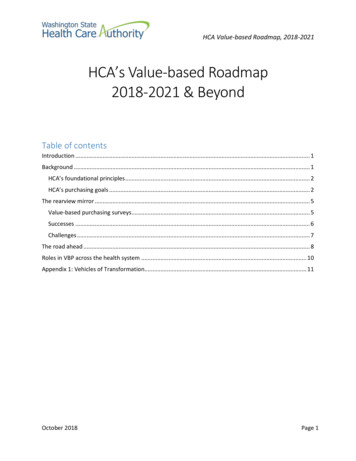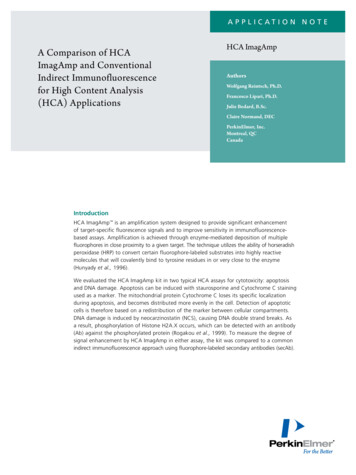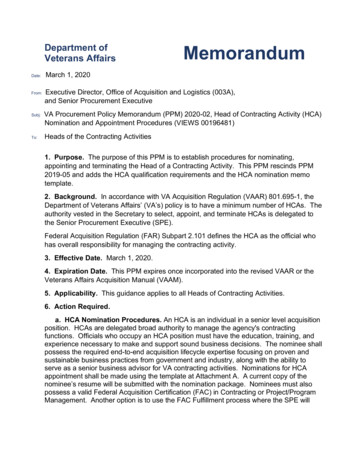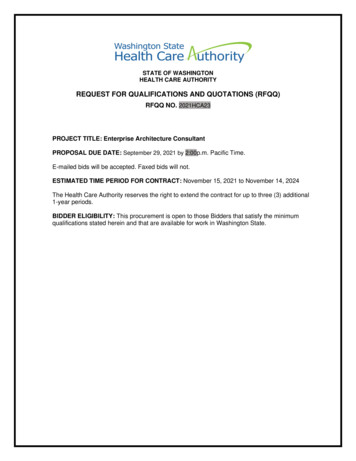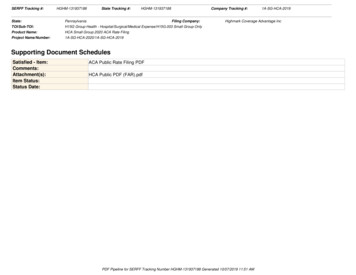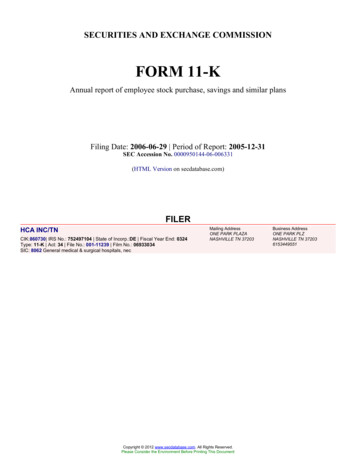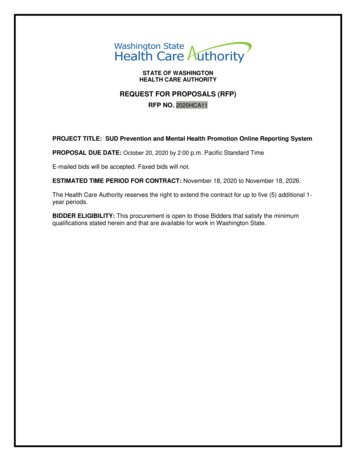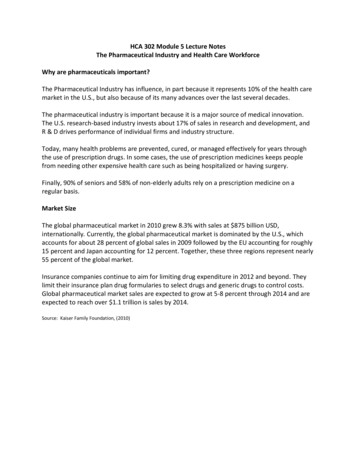
Transcription
HCA 302 Module 5 Lecture NotesThe Pharmaceutical Industry and Health Care WorkforceWhy are pharmaceuticals important?The Pharmaceutical Industry has influence, in part because it represents 10% of the health caremarket in the U.S., but also because of its many advances over the last several decades.The pharmaceutical industry is important because it is a major source of medical innovation.The U.S. research-based industry invests about 17% of sales in research and development, andR & D drives performance of individual firms and industry structure.Today, many health problems are prevented, cured, or managed effectively for years throughthe use of prescription drugs. In some cases, the use of prescription medicines keeps peoplefrom needing other expensive health care such as being hospitalized or having surgery.Finally, 90% of seniors and 58% of non-elderly adults rely on a prescription medicine on aregular basis.Market SizeThe global pharmaceutical market in 2010 grew 8.3% with sales at 875 billion USD,internationally. Currently, the global pharmaceutical market is dominated by the U.S., whichaccounts for about 28 percent of global sales in 2009 followed by the EU accounting for roughly15 percent and Japan accounting for 12 percent. Together, these three regions represent nearly55 percent of the global market.Insurance companies continue to aim for limiting drug expenditure in 2012 and beyond. Theylimit their insurance plan drug formularies to select drugs and generic drugs to control costs.Global pharmaceutical market sales are expected to grow at 5-8 percent through 2014 and areexpected to reach over 1.1 trillion is sales by 2014.Source: Kaiser Family Foundation, (2010)
Safety Stages of Drug ResearchLet’s take a brief look at the safety stages of drug research.First, during the preclinical assessment, the relative safety of newly-synthesized compounds isinitially evaluated in both in vitro (live animals) and in vivo (lab) tests. If a compound appears tohave important biological activity and may be useful as a drug, special tests are conducted toevaluate safety in the major organ systems (e.g., central nervous system, cardiovascular, andrespiratory systems). Other organ systems are evaluated when potential problems appear.These pharmacology studies are conducted in animals to ensure that a drug is safe enough tobe tested in humans. An important goal of these preclinical animal studies is to characterize anyrelationship between increased doses of the drug and toxic effects in the animals. Developmentof a drug is usually halted when tests suggest that it poses a significant risk for humans—especially organ damage, genetic defects, birth defects, or cancer.Next, is the pre-approval assessment in humans. A drug sponsor may begin clinical studies inhumans once the FDA is satisfied that the preclinical animal data do not show an unacceptablesafety risk to humans. It takes a few too many years for a clinical development program togather sufficient data to prepare a new drug aseeking FDA regulatory reviewto market a new drug.Next, during the FDA review, a sponsor submits an NDA to the FDA for approval tomanufacture, distribute, and market a drug in the U.S. based on the safety and efficacy dataobtained during the clinical trials. In addition to written reports of each individual studyincluded in the NDA, an application must contain an integrated summary of all availableinformation received from any source concerning the safety and efficacy of the drug.Once a drug has been approved and marketed, post-marketing surveillance occurs. Monitoringand evaluating a drug's safety becomes more complex at this point, because once on the
market, a drug will be taken by many more patients than in the clinical trials and physicians arefree to use it in different doses, different dosing regimens, different patient populations, and inother ways that they believe will benefit patients. Similarly, they must report all adverse effectscaused by the drug.The Health Care WorkforceThe leader of the health care team in most settings is the physician. Physicians in the U.S. aretrained via two schools of approach: allopathic or medical doctor (MD) and osteopathic, doctorof osteopathy (DO). The allopathic approach focuses on providing treatment for a disease orcondition, such as giving an antibiotic to treat an infection; the antibiotic treats the underlyingcause of the infection so that the patient can get well. The osteopathic approach is consideredmore holistic, focusing on the body’s ability to help heal itself. Osteopaths practice spinal andbody manipulation, because they believe that when the musculoskeletal system is in functionalalignment, supported by healthy environment, and proper nutrition, the body will be in a stateof health. In practice, most osteopathic physicians still use drugs and other therapies to treatpatient conditions in a similar way as allopaths; they simply have a more holistic approach.Mid-Level ProvidersMid-level practitioners (or physician extenders), such as physician’s assistants and nursepractitioners, form a category of health care providers seeing increased use. The term mid-levelconnotes more education, a higher level of responsibility, and more autonomy than entry levelclinicians, but less than the physician.Physician’s assistants (PAs) are caregivers who work with a physician who is responsible forsupervising their practice. PAs are governed by a state’s medical practice act and can onlyperform procedures under the supervision of a physician at the level stipulated by law. In somestates, PAs can write prescriptions acting under physician supervision. PA specialized educationis from 2-3 years in length with most graduates earning a bachelor’s degree, some a master’s.The nurse practitioner (NP) has additional clinical training and experience providing carebeyond the traditional role of nursing. Their role can include obtaining patients’ healthhistories, developing and managing a plan of care. NPs perform physical exams and canperform some procedures, governed by a state’s nursing practice act. Prescription authority isgiven in some states. NPs are prepared to function independently of physicians, but do consultthe physician for assistance when their patients’ needs go beyond the NPs expertise. Mostnurse practitioners receive additional training within a bachelor’s degree program and then goon to complete the nurse practitioner program to earn a master’s degree.These mid-level roles are designed to extend the role of the primary care or specialty physician,freeing the physician to spend more time with patients having more complex care needs or tocover additional needs in an underserved area.
Reimbursement for extender services is evolving. While not all government and private insurerswill reimburse for these services, this is expected to continue to grow with the growth ofmanaged care and the pressure to contain costs. While some physicians welcome extenders, inareas where there is an oversupply of physicians, extenders can be viewed as competition.Nurses make up the largest number of health care providers. Hospitals remain the largestemployer of nurses, though the numbers are changing as more care moves to outpatientsettings. Nurses provide for the physical care of patients, especially in hospitals and also in longterm care settings. In addition, nurses assess patients’ level of health, and how they areadjusting to the illness or condition they are experiencing and any treatment prescribed. Theyteach and counsel patients, helping them understand and adjust to their conditions. Here are afew facts about nurses (as of 2010) obtained from the U.S. Department of Labor: Largest health care occupation, with employment of over 2.4 million jobsWomen comprised 92.1% of RNsRNs will increase by 27.3% between 2002 and 2012 from 2,284,000 to 2,908,000U.S. Department of Labor, Women’s Bureau (2010). Quick facts on registered nurses. Retrieved mA nurse’s practice is governed by the individual state’s nursing practice acts. To prepare topractice nursing, education can take three pathways: an associate (2-year) degree, a decreasingnumber of diploma degree (3-year) programs offered in conjunction with hospitals, or througha baccalaureate (4-year) degree. In addition, both master’s degree and doctoral level programsin nursing are available for those who want to specialize in areas such as teaching,administration, or research.The profession has traditionally attracted primarily females, although recently, there has beensome growth in numbers of male nurses. As career options for women have increased, thenumber of women entering nursing has declined. The current and projected future shortage ofnurses is reaching an unprecedented level. A study by Deloitte and Touché predicted that in theyear 2020, only half of the nurses needed to care for the nation’s aged population will beavailable. The average age of the practicing nurse, according to the American Association ofColleges in Nursing (AACN), is 43.3. Given the trends and predictions, there are serious timesahead in dealing with the nursing supply shortages.Factors in the Nursing ShortageThe U.S. population and labor force is aging. There are fewer potential workers coming behindthe aging ‘baby boomer’ generation. Careers in staff nursing are seen as less attractive to thoseentering employment. Many nurses have gone into administrative roles. Many nurses are nowhitting retirement age, or have retired. There are shortages of nursing schools and nurseeducators, which impact how many nurses may be produced per year.
The Pharmaceutical Industry and Health Care WorkforceThe pharmaceutical business is now 10% or more of all medical service spending and isgrowing. Part of the equation of pharmaceutical research and development is that it hasoverhead. It may cost millions of dollars in R & D, clinical trials, and the FDA approval process inorder to get a drug to market. Once it goes to market, the company must report all benefits andadverse reactions to the FDA.The FDA process of approval is labor intensive. It must be that way, since their mission is toprotect the consumer. Besides drugs, the FDA also is responsible for approval of all food items,cosmetics, and medical devices. It is important for any health care administrator that works inhealth care services to understand how the FDA functions and the laws regulating controlledsubstances under the Controlled Substances Act of 1971. Under this act, physicians, hospitals,manufacturers, pharmacists and any other person who may dispense, prescribe or administer acontrolled substance must obtain from the Drug Enforcement Agency (DEA) an approvalnumber.The health care workforce is in dire need of medical personnel. The demand for quality healthcare services is only going to increase as the baby boomers continue to age, increasing the needfor more health care services. Shortages of health care providers will continue, due in part tothe amount of time it takes to train a medical provider, but also due to the lack of medicaleducators, which limits the number of students that may be produced per year. Many nurses,dissatisfied with their role, are transitioning to more administrative roles. Many nurses who areretiring are not being replaced. All of these things have made health care a challenge for ourfederal and state governments, who seek solutions in health care reform.
HCA 302 Module 5 Lecture Notes . limit their insurance plan drug formularies to select drugs and generic drugs to control costs. . cosmetics, and medical devices. It is important for any health care administrator that works in health care services to understand how the FDA functions and the laws regulating controlled
